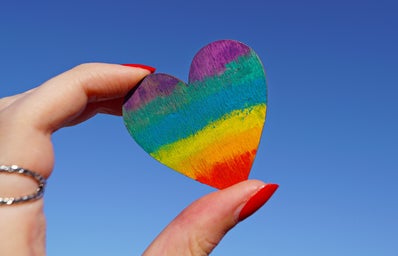July, pride month, celebrates the LGBTQIAP+ community and reaffirms their rights and inclusion in society. For this reason, you can see a variety of Pride flags spread across many major cities and even on the products of well-known brands such as Converse, Apple, and Adidas.
But it’s not about the companies selling the LGBTQIAP+ flags as a product, it is about making people aware of the struggles of the community. Last week, for example, the Brazilian rock band “Titãs” raised a Pride flag at the end of each of their 3 sold-out concerts in São Paulo, attended by a total of 150.000 people. Although the action that can be pretty common to some people, was important because it was able to reach an older audience. Since the band originated in the 80s, much of their fan base is made up of other generations, who are not always familiar with or used to talking openly about the LGBTQIAP+ community.
Nowadays, we still have huge social and political problems surrounding the existence of this community, which is always delegitimized and marginalized. However, there is a free space to discuss and learn more about it.
We need to understand what this community embraces for us to be more inclusive and open-minded. That’s why we made an alphabet soup describing every letter of the LGBTQIAP+ acronym.
- l – lesbian
-
“Lesbian” refers to women who are only attracted to other women. To clarify, It’s about their sexual orientation (what gender they are attracted to) and not about their gender identity (what gender they identify as man, woman, non-binary, gender fluid, and so on). There is no such thing as a woman being “a man” because they are a lesbian.
The words “lesbian” and also “sapphic” come from the Ancient Greek poet Sappho, who lived on the Greek island Lesbos (or Lesvos). Her poems talked a lot about homosexuality and her love for women, which some believe to be the reason why most of her work was eventually destroyed.
If you want to know more about the lesbian community, you should follow “Team2Moms” on social media. The lesbian couple, Ebony and Denise, share a little bit about their lives as mothers of three children and talk about parenthood, marriage, and the internet world.
- g – gay
-
“Gay” is the sexual orientation of a man who only feels attracted to men. However, the word can be used to refer to homosexuality in general, and sometimes to the LGBTQIAP+ community as a whole, such as “Gay parade” or “gay rights”, as an umbrella term.
The word originally meant something like “cheerful” and “joyful”. As the centuries passed, it was also used negatively to refer to something immoral and promiscuous, related to sex and prostitution. It was only in the 20th century that “gay” started being used to talk about homosexual men.
Sadly, decades later, the word gay is still used as an insult by some people, alongside other words used specifically to offend gay men, such as “faggy”. This kind of slur tries to invalidate their gender based on their sexuality, claiming they are not “true men” or “man enough”.
This stigma can be seen in the story of the coming out of Rob Halford, frontman of the heavy metal band “Judas Priest”, which started in 1969. With the fear that his sexuality would interfere with the success of the band, Halford took 27 years to come out as a gay man. He only did so in 1998, on MTV, 6 years later he had left the band, and still made some fans pretty upset.
- b – bisexual
-
Bisexual is anyone who is attracted to two or more genders. But it’s a little more complex than that.
When the word started being used, around the 19th century, it was to talk about someone who was attracted to men and women, in a binary view of gender identity. However, when other genders besides masculine and feminine started being more discussed and recognized, the term got broader. From that point on, bisexuality got the definition of liking two or more genders, just like today.If you already know a little bit about the LGBTQIAP+ community, you might be thinking right now “Isn’t that pansexuality?”. Well, the two terms have some similarities and differences. A Pansexual is someone who is attracted to people despite their gender identity. First off, bisexual and pansexual are words that come from different historical periods. Bisexual is an older word, and pansexuality is newer, from a time when different genders were already established. In addition, bisexuality doesn’t necessarily mean that someone is attracted to all genders, unlike pansexuality.
On the other hand, considering the word bisexual got broader and embraced all genders, a lot of people in the community feel like the two terms are interchangeable, and are ok with being called by both of them. Meanwhile, that is not the case for everyone, and some people feel that one term represents them better. Sexuality is, above all, a personal thing! Just ask people what they prefer being called, and don’t make assumptions!
- T – transgender
-
Transgender is anyone who doesn’t identify as the gender they were assigned at birth. In our still-binary society, people who are born with a penis are automatically attributed as being a man, and people born with a vagina are automatically considered a woman. But gender is not about the genitalia, it’s about how we view ourselves.
Gender is fluid, there are not only men and women, but there are also genders that don’t fit this binary pattern, such as non-binary, gender fluid, agender, bigender, and so much more. Yes, they are also transgender! Human beings are rational individuals, they can´t be classified as male or female like animals, we have identities.
The term transgender started being used in the 60s, at the time, mostly for trans men and women. Despite that, transgender people have existed since forever, and, just like the rest of the LGBTQIAP+ community, they have been oppressed and have to deal daily with prejudice and misconceptions. As an example, there is the Roman Emperor Elagabalus, who we now realize was probably a trans woman, since they preferred being called “Lady” rather than “Lord” and also looked for doctors who would do gender-reaffirming surgery and change their genitalia.Nowadays, gender transition made a lot of progress, and you can see that on the TikTok of Dylan Mulvaney, that shares the bad and good moments of her transition in the series “Day _ of Being a Girl”. Earlier this year, Dylan completed 365 days of being a woman.
- q – queer
-
Queer is an intentionally vague term. It’s an umbrella for anyone who doesn’t feel included in the heteronormative society but, at the same time, doesn’t want to label themselves with another letter from the LGBTQIAP+ acronym. Queer can refer to gender identity and sexuality. For example, you can be a Queer woman, a Queer pansexual, or even just Queer!
The word was an insult used towards the community, and it meant “odd” and “strange”. Although you can still see the word used derogatorily, it was reclaimed by the community, which we now call queer in a positive way. Queerness is about freedom and fluidity.
- i – intersex
-
Intersex is also a broad term. It represents people with a biological variation where they are born with characteristics from both the female and male sexes. They are proof that bodies – and gender – are not the traditional binary concepts that society promotes. Every intersexuality is different, it can be related to someone’s genitals, hormones, chromosomes, and so on.
The intersexual community has been fighting for their right to existence for centuries. They were considered an illness, an anomaly that should be fixed and studied by doctors, who also called the community “hermaphrodite” – a term we no longer use since it is a derogatory slur that affirms the idea that intersexuality is a disease.
Their fight is not over, and, to this day, intersex babies are subjected to surgeries and hormonal treatments so that they could fit the classifications of male and female. Although some countries have prohibited it, it’s still a struggle. They should have the right to learn how they identify themselves.
To know a bit more about intersexuality, you should check out “Da Lou” on social media, a black intersex Brazilian woman who tries to educate people about the community.
- a – asexual
-
Asexuality is a spectrum that comprehends people who lack sexual attraction. Some of them don’t experience it at all, others just aren’t that enthusiastic about it or only experience it sometimes. Don´t get it confused, they can experience other forms of attraction, such as emotional and romantic – although some of them don’t.
Ace, as some people call asexuals, is different from abstinence, they are not prohibiting themselves from doing something they want to. They just don’t feel the need to have sex as sexual people do, and that’s fine!
Since it’s a spectrum, there is no right way to be asexual, people deal with sex differently. Demisexuals, for example, only experience sexual attraction once they have a deep connection with someone. On the other hand, apothisexuals don´t enjoy the experience of sex at all and feel repulsed by it.There is so much more to it! Asexuality is a broad term that can embrace the specificities of anyone who doesn’t consider themselves sexual!
- p – pansexual
-
As mentioned when talking about bisexuality, pansexuality is the sexual orientation of people who feel attracted to people despite their gender. “Pan” in Greek means “all”, so, pansexuality means attraction to all genders.
The pansexual flag was created in 2010, and it is composed of a pink stripe on top, a yellow one in the middle, and a blue one at the bottom. Since the flag circulated freely on the internet, we don’t know exactly who created it. But, the common conception is that pink is supposed to represent women, blue men, and yellow every other gender of the LGBTQIAP+ community, to symbolize the inclusion of every gender.
In 2018, the famous actress Jane Monáe came out as pansexual in Rolling Stone Magazine. She considers herself a free queer individual that is open to learning more about herself. At first, she called herself a bisexual but after reading about pansexuality, she identified with it. Maybe that’s what pansexuality is all about the freedom of the heteronormative pattern of gender!
- +
-
Those are just some terms of the LGBTQIA+ community, there´s way more to it! Gender and sexuality – as you have seen – are complex and specific for every individual. The community is constantly evolving as it tries to accommodate everyone that doesn’t feel included in the heteronormative society.
————————–
The article above was edited by Clarissa Palácio.
Liked this type of content? Check Her Campus Casper Líbero home page for more!


